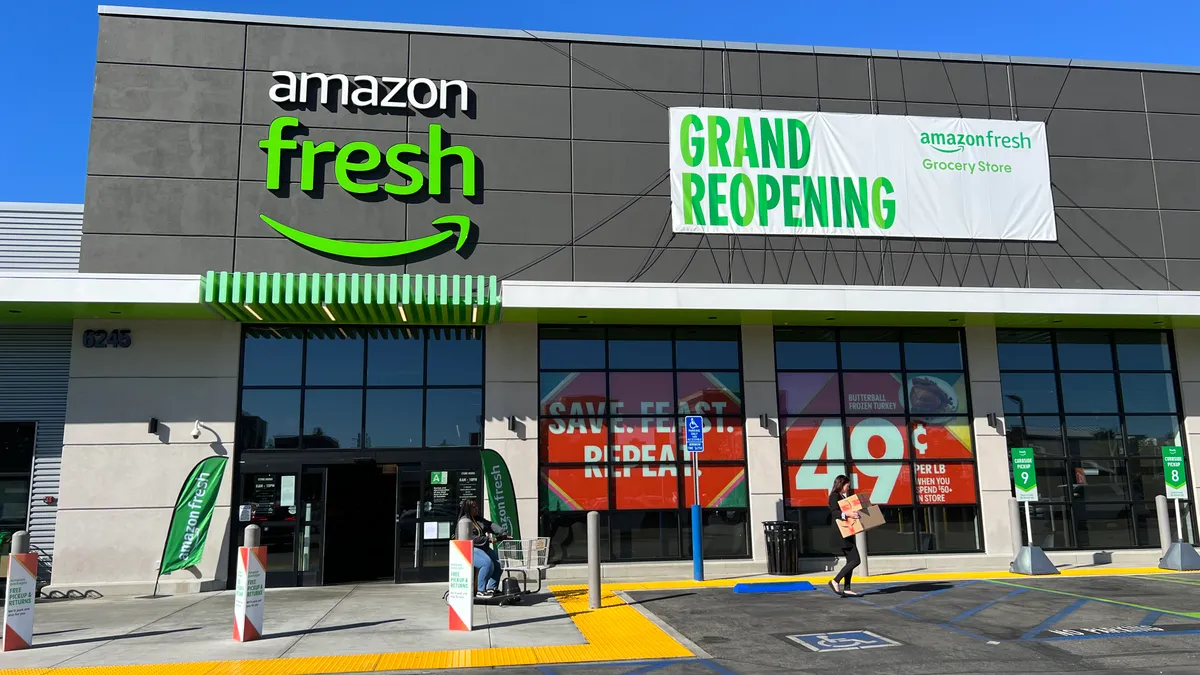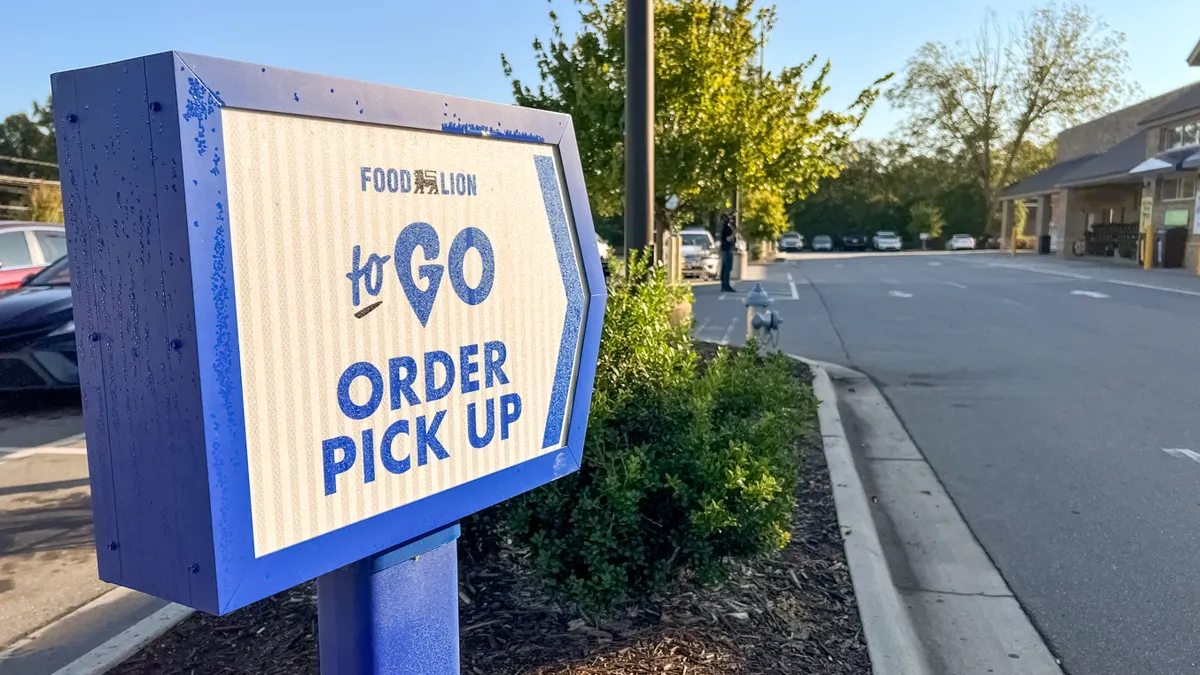Kroger’s online future has taken flight with an army of more than 1,000 robots performing a high-tech ballet across more than 350,000 square feet of warehouse space. Air-traffic control systems guide the bots' movements as they pick orders atop 21 levels of crates, with artificial intelligence optimizing their every motion and strategically placed human workers assisting them. Each order is fulfilled within minutes, then placed in vehicles that will either deploy directly to consumers’ homes or, more often, to cross-dock facilities, where they’ll be loaded into small vehicles and put out for delivery reaching more than 90 miles away from the automated customer fulfillment center (CFC).
The CFCs can also fulfill pickup orders for stores. And those stores will continue to fulfill same-day delivery orders through third-party delivery companies like Instacart. Eventually, automated micro-fulfillment facilities could get added to the mix, along with miniature CFCs, additional pickup depots and more.
Welcome to Kroger’s new digital ecosystem.
In a presentation on Wednesday, the grocer formally introduced its Ocado facilities that have been in the works for more than three years, highlighting features of their first automated facility in Monroe, Ohio. Much of the overall strategy was previously discussed during the company’s annual shareholder meeting late last month. But Kroger’s CEO Rodney McMullen and Yael Cosset, who is senior vice president and chief technology and digital officer, were joined this time around by Ocado Group Chief Executive Tim Steiner and Ocado Solutions CEO Luke Jensen, who provided additional details on the technology and how it will work specifically for Kroger.
All four executives stressed the flexibility and interconnectedness of the new system to fulfill orders through the best mode possible. "We optimize the fulfillment process by directing that demand, that order to a specific fulfillment mode. It could be a store, it could be a very large customer fulfillment center, a smaller one and so forth," said Cosset.
The approach promises to shave costs, win back margin in e-commerce and even become more profitable than stores in the long run. But it remains a big, risky bet for the nation’s largest grocer, and certain details — namely, the ability to compete for same-day delivery demand — as well as the companies’ ability to execute remain up in the air for now.
High volumes, new markets
Ocado’s CFCs are built to process a high volume of orders — a capability that has become much more relevant during a pandemic that’s super-charged online sales. Kroger’s digital sales more than doubled in 2020, reaching $10 billion, with delivery sales climbing 150%.
The Monroe, Ohio, facility can prepare a 50-item order in just five minutes, and one module of picking robots — each facility has several modules — can ready around 60 orders in three minutes, executives pointed out. That adds up to thousands of orders processed each day. Those orders are put in boxes and packed into vehicles in a sequence that maximizes efficiency.
“Every box is in a particular sequence. Every product is in a particular box and in a particular bag within that box,” said Steiner.
About a third of orders typically ship directly from Ocado’s warehouses to consumers' homes in vans packed with 20 orders, said Steiner, while around two-thirds are taken by truck to smaller “spoke” sites where they’re transferred into vans and then go out for delivery. Direct delivery from Kroger’s CFCs extends up to 90 miles, with spoke sites enabling delivery even beyond that.
On the front end, deliveries will be made by employees in Kroger Delivery branded vans, offering a contrast to the gig-economy approach many shoppers have grown accustomed to. Kroger Delivery features a fee structure that varies according to factors like delivery window popularity, lead time and customer loyalty. The company didn’t outline specific fees or offer examples, but the approach implies Kroger will apply its digital personalization capabilities to incentivize online shopping.
Kroger also touted an elevated service experience, noting its delivery drivers will be able to manage order changes, answer questions and let customers know about their loyalty membership benefits. Pay for delivery drivers starts at $18.45 an hour, McMullen said.
"That friendly driver gets to your home and is able to actually deliver on time, in full, but also have a conversation with the customer and know if something is wrong, they can make it right," said Gabriel Arreaga, Kroger's senior vice president of supply chain.
Kroger Delivery soft-launched from its Monroe facility last month and this week fulfilled its first order from its CFC in Groveland, Florida. These first facilities present two very different market scenarios, with the Ohio center positioned in the heart of Kroger’s operating market and close to its headquarters, while the Florida CFC is positioned deep into a state where the grocer only has a few stores. Here, Kroger will be competing against regional heavyweight Publix, which has a track record of making life difficult for newcomers.
McMullen said Kroger’s brand has around 55% awareness among Florida customers, pointing to the large numbers of residents moving into the state, including senior citizens, who previously lived in markets with Kroger stores. He said Kroger plans to eventually provide service throughout the state and up into southern Georgia and Alabama.
"When you look at overall high recognition in certain parts of the state, it's even higher than [55%], because an awful lot of people from Florida moved from the Midwest to Florida," McMullen said.
Kroger has committed to opening 11 CFCs with Ocado by the end of next year. Upcoming locations include Atlanta; Dallas; Frederick, Maryland; Phoenix; Pleasant Prairie, Wisconsin; and Romulus, Michigan. CFCs are also planned for the Pacific Northwest and West regions, but the exact locations have not been announced.
What about same-day service?
The massive Ocado warehouses may be capable of producing orders incredibly fast, but their large size means they're typically located miles outside of city centers and other service zones. Getting those orders to customers quickly presents a challenge
Indeed, while Ocado, which operates CFCs in several countries, is a specialist mainly in next-day service, many U.S. customers have become habituated to same-day service, sometimes in as little as an hour or two from when they place their order. It’s not clear how, or if, Kroger’s new digital facilities will address that demand stream. When asked about the ability to meet same-day demand, McMullen only spoke generally about the ability to meet a range of customer needs. Steiner, meanwhile, said Ocado’s CFCs are capable of siphoning more than half of their output into same-day deliveries, but didn’t say how Kroger might utilize this capability.
Kroger will continue to rely on its stores and on third-party services like Instacart to meet same-day demand. And executives have said they plan to improve order-fulfillment efficiency from their stores for delivery as well as the company's popular pickup service.
But that doesn’t present a meaningful differentiation from other grocers offering same-day delivery. With companies like Amazon pushing the needle on the speed of service and consumers showing an appetite for small- and medium-sized orders outside the conventional stock-up shop, Kroger could be at a disadvantage.
Competing grocers like Albertsons and Walmart have embraced automated micro-fulfillment centers (MFCs) as a way of integrating automation at a more localized level. Steiner said MFCs are “great for immediacy” but are more expensive to operate as a network than the CFC approach. Still, Ocado has built and tested MFCs in the U.K. and executives on Wednesday hinted that MFCs will eventually become part of Kroger’s new ecosystem.
“There's a place for [MFCs], there's a place for big sheds, and there’s a place for stores, and it's about having the best ecosystem to give the best service to the Kroger customer overall,” said Steiner.
Kroger's initially set a $50 million price tag on its Ohio CFC, but said in 2019 that the actual cost would be higher than that. On Wednesday, McMullen said the cost to build CFCs varies based on real estate costs, facility size and other factors.
Kroger has said its Ocado facilities will become profitable within four years as the company also ramps up its income from digital media. With online grocery estimated to be worth as much as $250 billion within the next five years, that may not be a far-fetched estimate. But a lot can happen in that time as competing companies roll out their own less-capital-intensive facilities and services in response to the e-commerce boom.
Kroger’s new digital ecosystem is a big, bold response the company believes is at scale with the biggest challenge facing grocers today. The question is, will that response be relevant for U.S. consumers over the long run?
"During Kroger's 138-year history, we've continually transformed the company numerous times, and this is one more evolution in terms of that transformation," said McMullen.






















